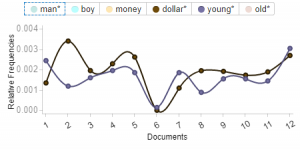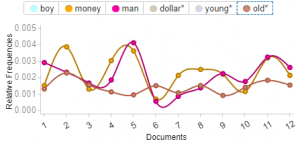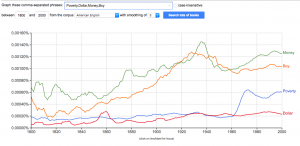The singular Alger text I chose to analyze was Do and Dare, also known as A Brave Boy’s Fight for Fortune. After reading Alger’s Wikipedia page, I gained a better perspective on Alger, and the themes and topics he touches on. For the most part, the Wikipedia article suggests that Alger primarily writes about impoverished boys who try to become more wealthy. By looking at the title of the text, I assume that this might be one of those stories. With this in mind, I 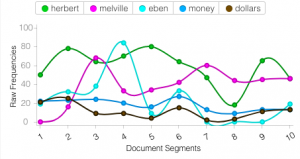 chose to look at the most frequent names: Herbert, Melville, and Eben and the terms “money” and “dollars”. After inputting the terms into Voyant, I saw the name that had the most intersecting points with the terms “money” and “dollars” was Eben. This is interesting because even though Eben has the highest amplitude, it is not the most frequent name spoken. The most frequent name was Herbert (582), the second: Melville (388), and lastly Eben (234). While all three names have intersecting points with each other, which implies that they have some type of relationship with each other, Herbert’s line does not touch the “money” and “dollars” line, and Melville touches the lines only once. These findings can also imply the class status of these characters as well.
chose to look at the most frequent names: Herbert, Melville, and Eben and the terms “money” and “dollars”. After inputting the terms into Voyant, I saw the name that had the most intersecting points with the terms “money” and “dollars” was Eben. This is interesting because even though Eben has the highest amplitude, it is not the most frequent name spoken. The most frequent name was Herbert (582), the second: Melville (388), and lastly Eben (234). While all three names have intersecting points with each other, which implies that they have some type of relationship with each other, Herbert’s line does not touch the “money” and “dollars” line, and Melville touches the lines only once. These findings can also imply the class status of these characters as well.
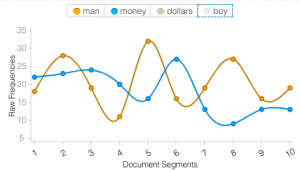 Intrigued by this discovery, I decided to look at the terms “boy” and “man” and kept the terms “money” and “dollars”. To some people, the words “money” and “dollars” mean the same thing and can be used interchangeably, but after inputting the terms into the frequency graph, I noticed an obvious trend. The term “man” had a more constant flow through the “money” line, and term “boy” fluctuated through the “dollar” line but at the end had one intersecting point with the “money” line. With the generalization that most adults had jobs, and earn wages– of course depending on other factors as well, “money” could be used more by the men in this text to discuss their pay. On the other hand, boys, esp
Intrigued by this discovery, I decided to look at the terms “boy” and “man” and kept the terms “money” and “dollars”. To some people, the words “money” and “dollars” mean the same thing and can be used interchangeably, but after inputting the terms into the frequency graph, I noticed an obvious trend. The term “man” had a more constant flow through the “money” line, and term “boy” fluctuated through the “dollar” line but at the end had one intersecting point with the “money” line. With the generalization that most adults had jobs, and earn wages– of course depending on other factors as well, “money” could be used more by the men in this text to discuss their pay. On the other hand, boys, esp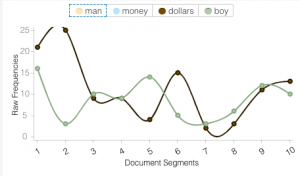 ecially during the 1800’s, either had no jobs or if they did, were paid less than a dollar. So the money they earned was by the dollar but could accumulate to more than a dollar which is suggested at the last intersecting points of the lines.
ecially during the 1800’s, either had no jobs or if they did, were paid less than a dollar. So the money they earned was by the dollar but could accumulate to more than a dollar which is suggested at the last intersecting points of the lines.
Moving on to the full corpus of the Alger texts, I decided to keep testing the terms “boy”, “man”, “money”, and “dollar”. The trends of all the lines seem to coincide with another which reinforces the idea that Alger tends to write about the wealthiness and/or impoverishment of both boys and men. However, I still wanted to explore the idea of the term “boys” being paired with the term “dollar” and the term “man” with “money”. Looking at the world map, I saw that the word “young” had a significant number. The word “old” was not on it but I decided to use it to see what the differences could be between the terms. Again I found that the paring of the terms “young” and “dollar” had many overlapping and intersecting points. In fact, both of the lines seem almost follow the same trend. Although both lines have a different starting point, it is at the first intersecting point they share the lines start to resemble one another. Now, the word “old” did not show the same amount of frequency as “man” and “money” but it still had a constant presence. However, the lines for “man” and “money”, had a similar trend on the graph.
After using Voyant, I went to the Google Ngram Viewer and searched the terms “poverty”,”dollar”, “money”, and “boy”. What I found interesting from the chart was that “money” and “boy” had a positive relationship, while “poverty” and “dollar” had an interesting relationship as well. What surprises me the most is how money does not intersect with poverty at all, considering how both terms are connected to each other.
By doing this distant reading on Alger, I think I brushed the surface of learning about the novel. From the data I collected, I learned how the theme of money might be important to the characters and the story as a whole. But other than that, I do not think I gained a much bigger perspective. However, the observations I found, and the patterns that emerged were intriguing, and probably something I could not have found by just reading the book. From doing this experiment, what I learned from not-reading Alger, is how much time it takes to do a distant reading. Of course, traditional close reading also takes time, but for distant reading, there is so much data that comes from one book that the reader can get lost in the information; and some of these observations can lead to discoveries or dead ends. Yet, if the reader wants to really understand the novel, I would suggest actually reading the novel to know the basic plot
